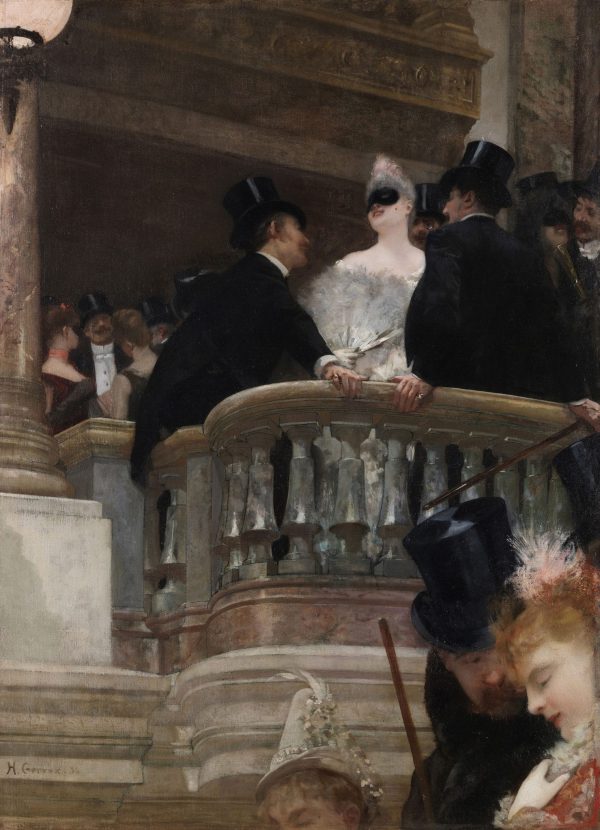Masked Ball at the Opera, Paris, 1886
Oil on canvas, H. 0.85 m; W. 0.63 m
Signed and dated Iower left: H. Gervex – 86.
Provenance: Henri Menier, Paris - acquired before 1904 and possibly directly from the artist.
Thence by descent.
- Paul Gilbert, “Les Petits Salons, place Vendôme,” Gazette des Beaux-Arts, 1886, p. 248.
- Jean-Christophe Gourvennec, “Réalisme social, réalisme mondain: les années 80,” Henri Gervex, 1853-1929, 1992, exh. cat., p. 145, illustrated in colour, p. 43.
Henry Gervex made his name during the 1880s as one of the boldest of the young artists who took Parisian social life and fin-de-siècle manners for their focus. In Le Bal de l’Opéra, painted in 1886, Gervex combined an immediately recognizable venue, the luxuriously grand foyer of Garnier’s new Paris Opéra House, with an even more distinctly French social event, the masked balls that enlivened the winter season and fascinated French and foreign audiences alike. With his dramatic cropping of the foreground figures (which brings the viewer right onto the famous Opéra staircase amid the departing revellers) and his strategic emphasis on the pervasive black suits, top hats and walking sticks of his stylish male figures, Gervex deftly acknowledged the Impressionist example of his close friends Manet and Degas. At the same time, his complex staging of intriguing story lines and careful attention to architectural details kept Gervex and the risqué subject matter of Le Bal de l’Opéra within the expectations of the still powerful academic establishment.
The extravagant masked costume balls that were held throughout Paris during the six weeks before Ash Wednesday and the Lenten restrictions were one of the city’ s most talked about spectacles. From midnight to five a.m., for the price of a ticket (balls at the Opéra were the most expensive at 10 fr, each), daring young women of the demi-monde (worldly, trendsetting young women whose conduct or lack of family pedigree set them apart from the traditional French social elite) could mix with men of aristocratic, financial and political prominence who flocked to the events. At the Opéra, the audience pit was cleared for dancing and the Opéra orchestra itself provided waltzes, mazurkas, and even the controversial cancan. Women dressed as glamorized stevedores, stage-y shepherdesses, or in any other costume that revealed more of their figures than street dress permitted, could dance with abandon, their reputations protected by small black domino masks that gave the allusion of anonymity. Men might dance, but mostly they watched and hoped to arrange a post-bal rendezvous. As the century progressed, what had begun as simple pre-Lenten entertainment for the city’ s students and working classes became a glamorous, distinctly Parisian phenomenon. In the 1850s, Gavarni drew pretty young seamstresses and tipsy art students collapsed after a bal in a grubby garret; when Manet painted the crowded old Opéra galleries in 1873 (fig. 1), the mass of top-hatted gentlemen, outnumbering the young women four to one, included journalists and friends of the artist, even Manet himself. With Gervex’s Le Bal de l’Opéra in 1886, the popular appeal revolved around guessing what leading actress or society hostess was featured flirting with which banker or politician on the central balcony.
Gervex had captured the attention of Paris in 1878 with a magnificently detailed painting of a dissolute young man contemplating suicide after a last night with a beautiful, still-sleeping prostitute, whose discarded dress, petticoats, and especially provocative corset were jumbled into the painting’s lower corner. Removed from the Salon as an affront to moral decency — despite the artist’s widely recognized source in a poem by the much-admired Alfred de Musset — the painting of Rolla was displayed in a nearby dealer’s window to great acclaim (Bordeaux, Musée des Beaux-Arts). Throughout the 1880s, Gervex continued to challenge the Salon with incidents from contemporary life: portraits of well-known courtesans, an autopsy, a view of butcher shops. Trained for five years in the academic studio of Cabanel, Gervex was nonetheless deeply influenced by Degas and Manet, and carefully created his own way between the Impressionist insurgency and academic complacency
For more than a century, Gervex’s Le Bal de l’Opéra has remained in the family of the painting’ s original purchaser. Henri Menier, the scion of a family of internationally successful chocolate manufacturers, acquired the painting early in the 1900s. Chocolat Menier, combining skilled chemistry and manufacturing techniques with delightful, vibrant advertising, was a leading chocolate maker in France, England, and America until the firm was acquired by Nestlé. During the twentieth century, the family was particularly known for its purchase and careful restoration of the Château de Chennonceau with its extraordinary roots in French royal history and superb old master collections.
This catalogue entry was written by Alexandra Murphy.
